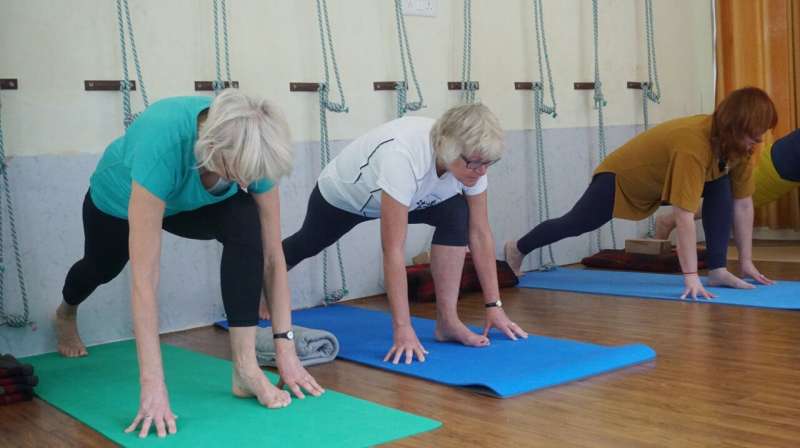
Cardiovascular disease is the leading cause of mortality in breast cancer survivors. A new study out of the Baker Heart and Diabetes Institute has found that exercise training three to four times per week protects against heart damage and losses in cardiovascular fitness experienced by breast cancer patients undergoing chemotherapy.
During a three-month course of chemotherapy, the average breast cancer patient loses 10–15% of their cardiovascular fitness, the same loss as would be expected with 10 years of normal aging.
In the BREXIT study, published in Circulation and presented at the American Heart Association Scientific Sessions 2022 in Chicago, patients who participated in 12 months of exercise training over the course of their breast cancer treatment improved their cardiovascular health by on average 8%, or eight years’ worth of fitness, lead researcher Dr. Steve Foulkes said.
“What we’ve found is that the women who were in the supervised exercise group didn’t experience the reductions in fitness and heart function that we saw in those who underwent cancer treatment according to current usual care standards,” Dr. Foulkes said.
“Instead, by exercising during chemotherapy, and continuing to exercise in the months after chemotherapy, they ended up healthier than before even starting treatment. So, exercise didn’t just prevent the losses associated with chemotherapy, it actually helped them recover to a better level of cardiovascular health than prior to starting breast cancer treatment.
“The other really important thing we found is that not only was fitness better, but when we took MRI images of their heart pumping while they were exercising, we saw this was also improved by about 10–12%. So, the significant thing is they’re fitter, but they’re fitter because their heart is pumping much better than before treatment, compared to a small loss in pumping capacity that we saw with chemotherapy.”
Chemotherapy treatment is already known to damage the heart, its blood vessels, and skeletal muscle, all of which are important mechanisms that help us to exercise and contribute to our exercise capacity. Therefore, when the heart of someone undergoing chemotherapy loses pumping capacity, there’s less oxygen reaching the muscles, which is further compounded by a reduced ability of the muscles to use the oxygen that does reach them. This can contribute to “functional disability,” which is the sensation of excessive fatigue or breathlessness with normal daily activities such as sweeping, vacuuming, climbing stairs or walking up a slight incline (it’s a threshold of fitness that is required for simple daily tasks).
The study found that none of the patients were functionally disabled if they were able to consistently perform two-to-three weekly sessions throughout the full 12 months of the study. In contrast, one in every five subjects who did not consistently exercise were disabled at 12 months.
“In addition to protecting against the direct damage caused by chemotherapy, we think that exercise probably counteracts that general deconditioning effect that also occurs during chemotherapy,” Dr. Foulkes said. “Even though it sounds somewhat counterintuitive—where the logical response to feeling fatigued during chemotherapy is to rest and protect the body from stressful things like exercise—exercise actually acts as a signal or stimulus to help generate energy, and it activates pathways that help to protect the body from the physical stresses in day-to-day life, including chemotherapy.”
Exercise also helps to improve the body’s immune profile, which is a key in our recovery processes from bodily stresses like chemotherapy.
“If we have a well-regulated immune system, the body can recover more efficiently,” Dr. Foulkes said. “And exercise is also thought to help with metabolic processing of the drugs themselves, so the tumor may receive more delivery of the chemotherapy and the rest of the body is able to better deal with its side effects.”
It is hoped that the findings lead to better access to and more targeted rehabilitation programs for breast cancer patients.
“Maybe we need to think more broadly about rehabilitation services offered to cancer survivors, and instead of someone with heart disease going to cardiac rehab and someone with cancer going to cancer rehab, we need to think more about these integrative rehab models that focus on heart health in cancer survivors,” Dr. Foulkes said.
“So, the hope would be to extend the kind of programs that are currently available to people with heart disease to those who might be at risk of heart disease, such as breast cancer patients, because this study has shown that if you give cancer patients access to some specific guidance and someone to support them to exercise, they get significant benefits and really engage with the exercise training itself.
“Essentially, the study demonstrates that people with breast cancer live better after treatment if they exercise regularly. Exercise should be considered as an essential part of cancer treatment alongside the medications prescribed. It decreases the toxicity of chemotherapy and may improve its effectiveness.”
Source: Read Full Article
